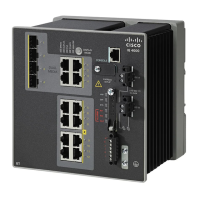Connecting Devices to the Ethernet Ports
The Ethernet ports use standard RJ-45 connectors with Ethernet pinouts. The maximum cable length is 328
feet (100 meters). The 100BASE-TX and 1000BASE-T traffic requires Category 5, Category 5e, or Category
6 UTP cable. The 10BASE-T traffic uses Category 3 or Category 4 cable.
The autonegotiation feature is enabled by default on the switch. At this setting, the switch ports configure
themselves to operate at the speed of the attached device. If the device does not support autonegotiation, you
can set the switch port speed and duplex parameters. To maximize performance, either let the ports autonegotiate
both speed and duplex, or set the port speed and duplex parameters on both ends of the connection.
For simplified cabling, the automatic medium-dependent interface crossover (auto-MDIX) feature is enabled
by default. With auto-MDIX enabled, the switch detects the required cable type for copper Ethernet connections
and configures the interface accordingly. Therefore, you can use either a crossover or a straight-through cable
for connections to a Ethernet port, regardless of the type of connected device.
See the switch software configuration guide or the switch command reference on Cisco.com for more
information about autonegotiation and auto-MDIX.
If auto-MDIX is disabled, use the guidelines in Cable and Connectors, on page 61 to select the cable for
connecting the Ethernet ports to other devices.
When using PoE/PoE+, those ports have the same autonegotiation settings and cabling requirements as those
in Connecting Devices to the Ethernet Ports, on page 34 . These ports provide PoE power.
See Cable and Connectors, on page 61 for information on the cables and connectors.
The ports provide PoE/PoE+ support for devices compliant with IEEE 802.3af/at and also provide Cisco
prestandard PoE/PoE+ support for Cisco IP Phones and Cisco Aironet Access Points.
On a per-port basis, you can control whether or not a port automatically provides power to a connected IP
phone or an access point.
To access an advanced PoE planning tool, use the Cisco Power Calculator on Cisco.com:
http://tools.cisco.com/cpc/launch.jsp
You can use this application to calculate the power supply requirements for a specific PoE/PoE+ configuration.
The results show output current, output power, and heat dissipation.
Voltages that present a shock hazard may exist on Power over Ethernet (PoE) circuits if interconnections are
made using uninsulated exposed metal contacts, conductors, or terminals. Avoid using such interconnection
methods, unless the exposed metal parts are located within a restricted access location and users and service
people who are authorized within the restricted access location are made aware of the hazard. A restricted
access area can be accessed only through the use of a special tool, lock and key or other means of security.
Statement 1072
Warning
Category 5e and Category 6 cables can store high levels of static electricity. Always ground the cables to a
suitable and safe earth ground before connecting them to the switch or other devices.
Caution
Cisco IE 4010 Switch Hardware Installation Guide
34
Switch Installation
Connecting Devices to the Ethernet Ports

